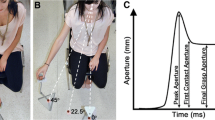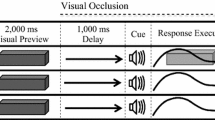Abstract
Right-hand preference has been demonstrated for visually guided reaching and grasping. Grasping, however, requires the integration of both visual and haptic cues. To what extent does vision influence hand preference for grasping? Is there a hand preference for haptically guided grasping? Two experiments were designed to address these questions. In Experiment 1, individuals were tested in a reaching-to-grasp task with vision (sighted condition) and with hapsis (blindfolded condition). Participants were asked to put together 3D models using building blocks scattered on a tabletop. The models were simple, composed of ten blocks of three different shapes. Starting condition (Vision-First or Hapsis-First) was counterbalanced among participants. Right-hand preference was greater in visually guided grasping but only in the Vision-First group. Participants who initially built the models while blindfolded (Hapsis-First group) used their right hand significantly less for the visually guided portion of the task. To investigate whether grasping using hapsis modifies subsequent hand preference, participants received an additional haptic experience in a follow-up experiment. While blindfolded, participants manipulated the blocks in a container for 5 min prior to the task. This additional experience did not affect right-hand use on visually guided grasping but had a robust effect on haptically guided grasping. Together, the results demonstrate first that hand preference for grasping is influenced by both vision and hapsis, and second, they highlight how flexible this preference could be when modulated by hapsis.



Similar content being viewed by others
References
Annett J, Annett M, Hudson PTW, Turner A (1979) The control of movement in the preferred and the non-preferred hands. Q J Exp Psychol 31:641–652
Bartolomeo P (2006) A parietofrontal network for spatial awareness in the right hemisphere of the human brain. Arch Neurol 63:1238–1241
Benton AL, Varney NR, de Hamsher KS (1978) Lateral differences in tactile directional perception. Neuropsychologia 16:109–114
Bishop DV, Ross VA, Daniels MS, Bright P (1996) The measurement of hand preference: a validation study comparing three groups of right-handers. Br J Psychol 81:269–285
Bratzke D, Seifried T, Ulrich R (2012) Perceptual learning in temporal discrimination: asymmetric cross-modal transfer from audition to vision. Exp Brain Res 221:205–210
Brown S, Roy E, Rohr L, Bryden P (2006) Using hand performance measures to predict handedness. Laterality 11:1–14
Bryden PJ, Roy EA (2006) Preferential reaching across regions of hemispace in adults and children. Dev Psychobiol 48:121–132
Bryden MP, Singh M, Steenhuis R, Clarkson KL (1994) A behavioral measure of hand preference as opposed to hand skill. Neuropsychologia 32:991–999
Bryden PJ, Pryde KM, Roy EA (2000) A performance measure of the degree of hand preference. Brain Cogn 44:402–414
Butler AJ, James KH (2011) Cross-modal versus within-modal recall: differences in behavioral and brain responses. Behav Brain Res 224:387–396
Calvert GA, Bishop DV (1998) Quantifying hand preference using a behavioural continuum. Laterality 3:255–268
Carlier M, Doyen A-L, Lamard C (2006) Midline crossing: developmental trend from 3 to 10 years of age in a preferential card reaching task. Brain Cogn 61:255–261
Connolly JD, Goodale MA (1999) The role of visual feedback of hand position in the control of manual prehension. Exp Brain Res 125:281–286
De Renzi E, Faglioni P, Scotti G (1969) Impairment of memory for position following brain damage. Cortex 5:274–284
Easton RD, Greene AJ, Srinivas K (1997) Transfer between vision and haptics: memory for 2-D patterns and 3-D objects. Psychon Bull Rev 4:403–410
Fagard J, Marks A (2000) Unimanual and bimanual tasks and the assessment of handedness in toddlers. Dev Sci 3:137–147
Fagot J, Hopkins WD, Vauclair J (1993) Hand movements and hemispheric specialization in dichhaptic explorations. Percept 22:847–853
Förster J (2011) Local and global cross-modal influences between vision and hearing, tasting, smelling, or touching. J Exp Psychol 140:364–389
Gabbard C, Rabb C (2000) What determines choice of limb for unimanual reaching movements? J Gen Psychol 127:178–184
Gabbard C, Tapia M, Helbig CR (2003) Task complexity and limb selection in reaching. Int J Neurosci 113:143–153
Gonzalez CL, Goodale MA (2009) Hand preference for precision grasping predicts language lateralization. Neuropsychologia 47:3182–3189
Gonzalez CL, Whitwell RL, Morrissey B, Ganel T, Goodale MA (2007) Left handedness does not extend to visually guided precision grasping. Exp Brain Res 182:275–279
Gottfried AW, Rose SA, Bridger WH (1977) Cross-modal transfer in human infants. Child Dev 48:118–123
Held R (2009) Visual-haptic mapping and the origin of cross-modal identity. Optom Vis Sci 86:595–598
Hupp JM, Sloutsky VM (2011) Learning to learn: from within-modality to cross-modality transfer in infancy. J Exp Child Psychol 110:408–421
Kritikos A, Beresford M, Castiello U (2002) Tactile interference in visually guided reach-to-grasp movements. Exp Brain Res 144:1–7
Mamolo CM, Roy EA, Bryden PJ, Rohr LE (2004) The effects of skill demands and object position on the distribution of preferred hand reaches. Brain Cogn 55:349–351
Mamolo CM, Roy EA, Bryden PJ, Rohr LE (2005) The performance of left-handed participants on a preferential reaching test. Brain Cogn 57:143–145
Mamolo CM, Roy EA, Rohr LE, Bryden PJ (2006) Reaching patterns across working space: the effects of handedness, task demands, and comfort levels. Laterality 11:465–492
Melmouth DR, Finlay AL, Morgan MJ, Grant S (2009) Grasping deficits and adaptations in adults with stereo vision losses. Invest Ophthalmol Vis Sci 50:3711–3720
Millar S, Al-Attar Z (2005) What aspects of vision facilitate haptic processing? Brain Cogn 59:258–268
Milner B, Taylor L (1972) Right-hemisphere superiority in tactile pattern-recognition after cerebral commissurotomy: evidence for nonverbal memory. Neuropsychologia 10:1–15
Newell FN, Ernst MO, Tjan BS, Bülthoff HH (2001) Viewpoint dependence in visual and haptic object recognition. Psychol Sci 12:37–42
Norman JF, Clayton AM, Norman HF, Crabtree CE (2008) Learning to perceive difference in solid shape through vision and touch. Perception 37:185–196
Oldfield RC (1971) The assessment and analysis of handedness: the Edinburgh inventory. Neuropsychologia 9:97–113
Pettypiece CE, Goodale MA, Culham JC (2010) Integration of haptic and visual cues in perception and action revealed through cross-modal conflict. Exp Brain Res 201:863–873
Reales JM, Ballesteros S (1999) Implicit and explicit memory for visual and haptic objects: cross-modal priming depends on structural descriptions. J Exp Psychol 25:644–663
Riege WH, Metter EJ, Williams MV (1980) Age and hemispheric asymmetry in nonverbal tactual memory. Neuropsychologia 18:707–710
Sacrey LR, Karl JM, Whishaw IQ (2012) Development of rotational movements, hand shaping, and accuracy in advance and withdrawal for the reach-to-eat movement in human infants aged 6 to 12 months. Infant Behav Dev 35:543–560
Schettino LF, Adamovich SV, Poizner H (2003) Effects of object shape and visual feedback on hand configuration during grasping. Exp Brain Res 151:158–166
Serrien DJ, Ivry RB, Swinnen SP (2006) Dynamics of hemispheric specialization and integration in the context of motor control. Nat Rev Neurosci 7:160–167
Squeri V, Sciutti A, Gori M, Masia L, Sandini G, Konczak J (2012) Two hands, one perception: how bimanual haptic information is combined by the brain. J Neurophysiol 107:544–550
Stone KD, Bryant DC, Gonzalez CLR (2013) Hand use for grasping in a bimanual task: evidence for different roles? Exp Brain Res 224:455–467
Thinus-Blanc C, Gaunet F (1997) Representation of space in blind persons: vision as a spatial sense? Psychol Bull 121:20–42
Tomlinson SP, Davis NJ, Morgan HM, Bracewell RM (2011) Hemispheric specialisation in haptic processing. Neuropsychologia 49:2703–2710
Vallar G (1997) Spatial frames of reference and somatosensory processing: a neuropsychological perspective. Philos Trans R Soc Lond B Biol Sci 352:1401–1409
Vogel JL, Bowers CA, Vogel DS (2003) Cerebral lateralization of spatial abilities: a meta-analysis. Brain Cogn 52:197–204
Volcic R, Wihntjes MW, Kool EC, Kapper AM (2010) Cross-modal visuo-haptic mental rotation: comparing objects between the senses. Exp Brain Res 203:621–627
Winges SA, Weber DJ, Santello M (2003) The role of vision on hand pre-shaping during reach to grasp. Exp Brain Res 152:489–498
Wismeijer DA, Gegenfurtner KR, Drewing K (2012) Learning from vision-to-touch is different than learning from touch-to-vision. Front Integr Neurosci 6:105
Author information
Authors and Affiliations
Corresponding author
Rights and permissions
About this article
Cite this article
Stone, K.D., Gonzalez, C.L.R. Grasping with the eyes of your hands: Hapsis and vision modulate hand preference. Exp Brain Res 232, 385–393 (2014). https://doi.org/10.1007/s00221-013-3746-3
Received:
Accepted:
Published:
Issue Date:
DOI: https://doi.org/10.1007/s00221-013-3746-3




